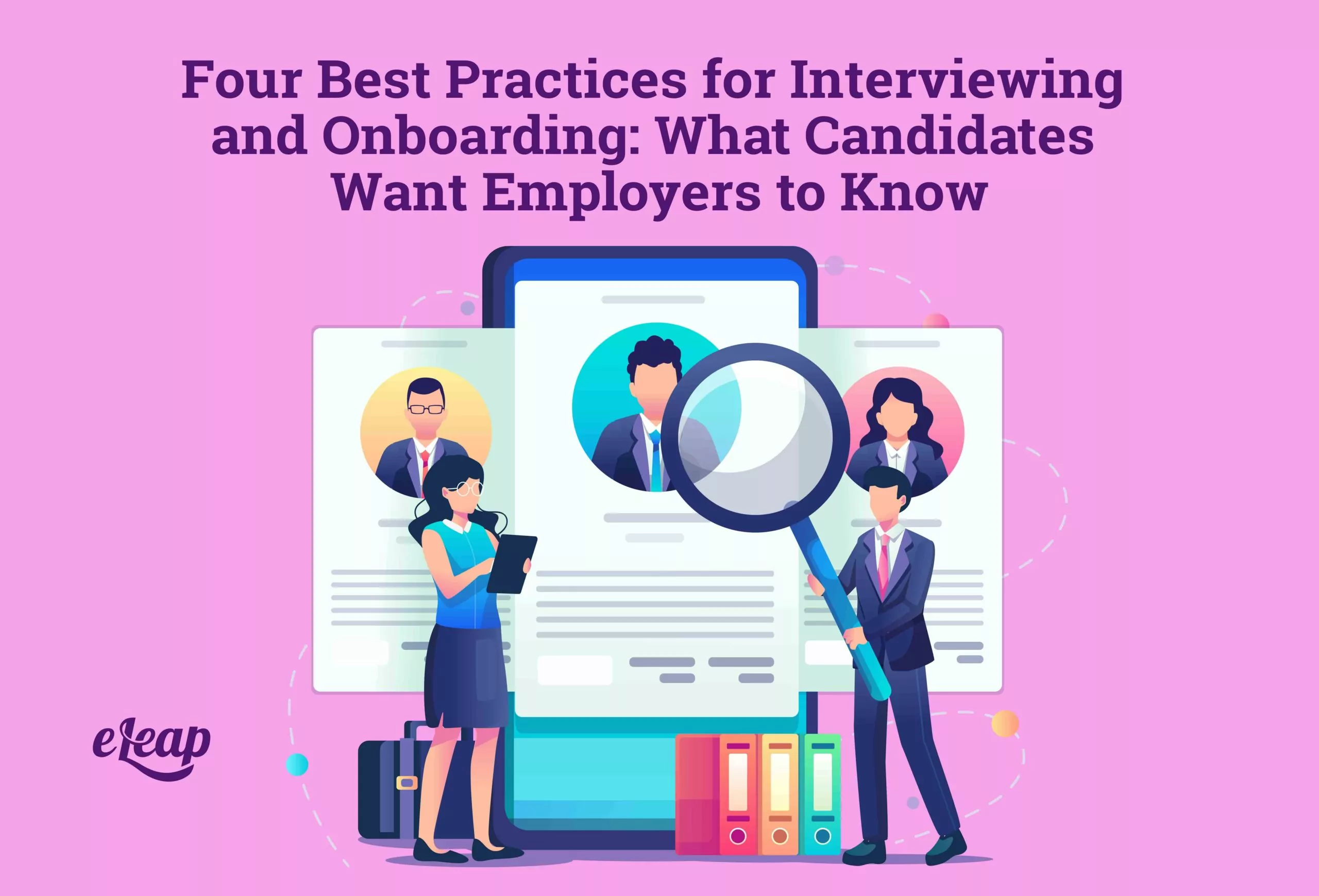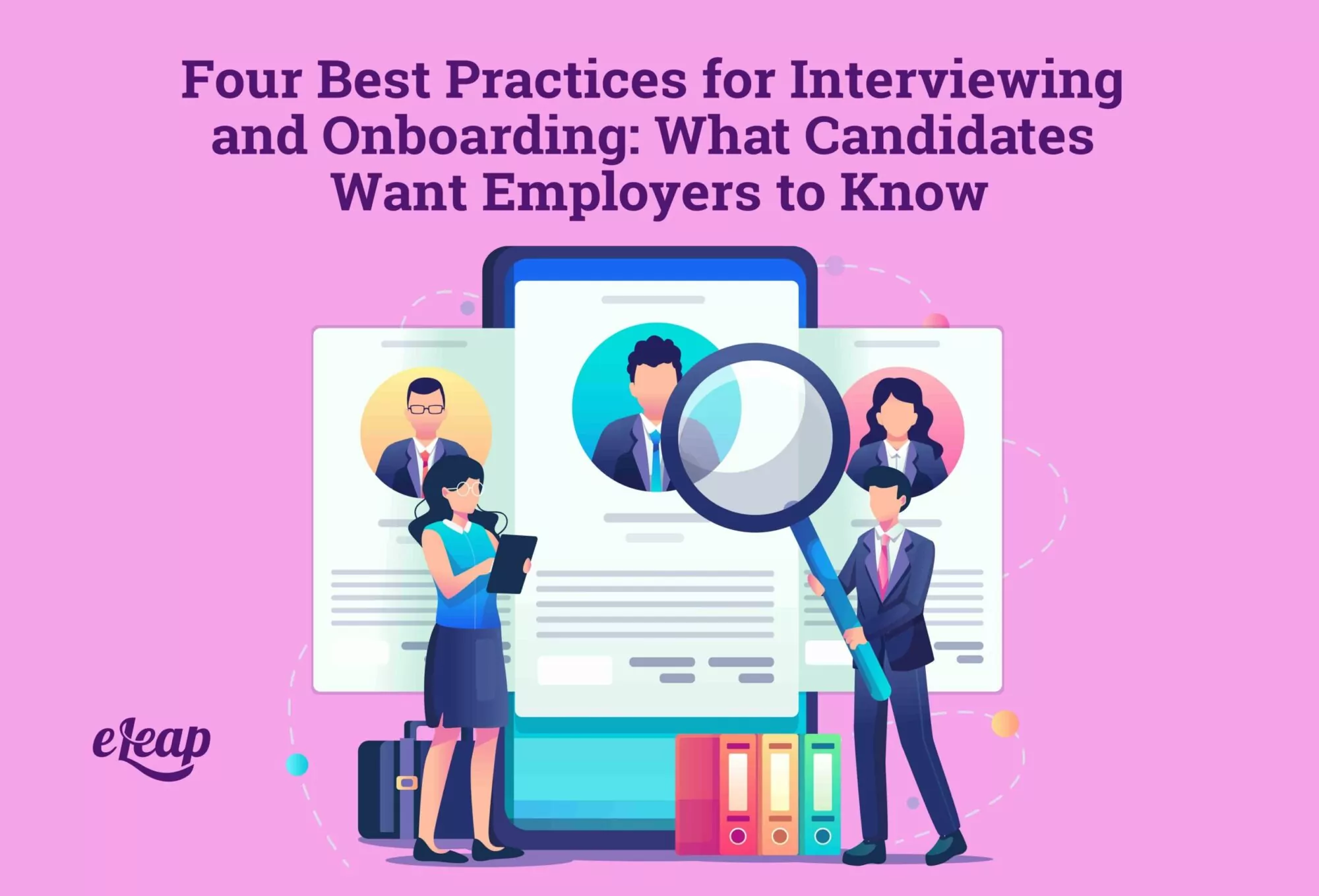Four Best Practices for Interviewing and Onboarding: What Candidates Want Employers to Know

Businesses are functioning in a new world of work—one where candidates have the upper hand and companies are vying for the best talent in a now-global pool. Employers used to be able to create their own recruitment and onboarding processes and expect employees to fall in line. Today, candidates are demanding a better experience in several ways, and they’re not taking positions with companies that don’t listen to their needs.
Here’s what employers need to know about interviewing and onboarding in the current economy and employment climate.

Get Compliance and Paperwork Out of the Way
Once you’ve decided that you’re going to hire someone, you need to make sure that you cover compliance topics and tedious paperwork as soon as possible. Don’t expect people to do this on their time, by any means, but make sure that it’s a priority for day one of training or onboarding so that it’s done, and you can get on with the more enjoyable part of welcoming someone new to the company.
If there are compliance factors relevant to the position, certifications or degrees required, and so forth, be clear about those upfront, so that you don’t waste candidates’ time when they aren’t going to be eligible for the position anyway.
Encourage Open Communication
Too often, candidates feel like they’re sitting in a proverbial waiting room, just going on with life and hoping for their number to be called, as it were. This can create a feeling of one-way communication, where candidates wait for the employer to reach out and don’t take a proactive approach with questions or interests. Make sure that candidates feel comfortable reaching out to you—and through various channels—throughout the entire interview and onboarding process.
Don’t approach candidates as a company that is looking to hire. Approach them as a person from a company that is looking to hire someone. When people feel like they’re talking to other people, not figureheads, they’ll be much more comfortable with open communication. This will ensure that people always feel like they can reach out to the organization, no matter what their questions or concerns might be.
This includes feedback. Invite people to give it and be willing to give it in return when they ask. You should also be ready to accept any feedback that you get and use it to rethink your onboarding process. After all, who better to tell you where things might need some adjustment than those who have been through the process?
Stay in Touch Leading Up to Their First Day
Too often, employees feel like they’re left hanging during the recruiting and interviewing process. Companies are busy and times are different, yes, but that’s no reason to keep people waiting and guessing. From the moment that you decide to interview someone, stay in touch regularly. Even if you have no updates, but it’s been close to a week, let the candidates know that you’re still waiting on whatever it is.
Most importantly, don’t tell people you’ll contact them and then drop the ball. These days, ghosting is more common than ever, even in the workforce, and people are getting a really bad taste in their mouths from it. Perhaps you just got busy and aren’t really “ghosting” them, but they don’t know that. If you keep in touch, people will feel connected from day one and feel more comfortable reaching out.
Start Culture Immersion During Onboarding
From giving new candidates tours of the building to delivering a presentation on the company, its culture, and the people they’ll be working with, there are several ways that you can get people involved with culture from day one. This will improve the onboarding experience and help them feel less like the “new kid” that’s coming in late to the game and expecting to play. From getting the whole team involved to making sure there are events that take place around the time new hires come on board, there’s a lot you can do.
This is all about making sure that people feel a sense of belonging and they understand the culture of the organization. It also ensures that they’re aligned with that culture and that they feel connected to the mission of the company. This will help them perform their job better, too, since they feel like they’re a valued member of the team.
It’s About Treating People Like People
The biggest shift that’s going on in light of the Great Resignation is that candidates are no longer willing to sit around and wait, vying for your attention, and not expecting anything in return. Today’s candidates want to be involved, informed, and engaged. There’s no reason that the hiring process should take weeks or months. When you change the way that you approach interviewing and onboarding, you’ll get a more efficient process and be able to fill roles faster. That will ensure the entire organization keeps running as it should.
Putting the “H” Back in HR
Candidates are people. They’re not numbers, machines, or pawns in an organization’s path to success. Modern HR teams and organizations are finding that taking a more personalized approach to interviewing and onboarding, as well as offering a more personable demeanor, will ensure that candidates feel welcome, appreciated, and like they are going to be working with a great organization. That will lead to increased engagement, increased retention, and more.
Not only that, but it will help you build a stronger culture and connect with your people in a way that you probably never have. This is the future of business—people working together to offer the best solution(s). You might be thinking that’s been the case for years, but you forget that there wasn’t a lot of focus on the people and their humanness. A shift to focus on that will ensure that companies find the best talent with the right onboarding and interviewing processes, which also leads to improved performance management.